ISSN: 1204-5357
ISSN: 1204-5357
| Adam Stecyk University of Szczecin, Department of Management and Economics of Services Postal Address: ul. Cukrowa 8, 71-004 Szczecin, Poland Email: adam.stecyk@wzieu.pl |
| Marcin Chojnowski University of Szczecin, Department of Management and Economics of Services Postal Address: ul. Cukrowa 8, 71-004 Szczecin, Poland Email: marcin.chojnowski@wzieu.pl |
Visit for more related articles at Journal of Internet Banking and Commerce
LAMS WZiEU project began in 2006. The biggest challenge of adopting an e-learning environment was the methodological and electronic development of chosen parts of the Computer Science subject and transferring didactic content delivered by traditional methods into e-learning language. As is shown from the executed analysis, the general rating of efficiency and quality of blended learning was twice as high as the traditional method. According to the students, blended learning is better in every element of the educational process, except communication. It seems that it is very important to find which must be taken into consideration when other e-courses are designed. Essential are solutions for synchronous communication or, going further, e-consultation tools. The general rating for the efficiency of the method was positive for both students and teachers.
Keywords |
| LAMS, blended learning, cost-effectiveness, learning design, evaluation |
1. The characterization of LAMS WZiEU project – stage one |
| The beginning of the LAMS WZiEU project was in 2006, when contact was established between the Department of Management and Economics of Services (WZiEU) of University of Szczecin and the Macquarie E-Learning Centre of Excellence (MELCOE) of Macquarie University in Sydney. This collaboration involved a scholar visits by the authors to Macquarie University, resulting in the creation of the Polish version of LAMS (Learning Activity Management System) and the first implementation of the Australian e-learning and blended learning platform in Poland. |
| In April 2007, the LAMS WZiEU project team was founded to realize the first stage of LAMS WZiEU project. The table below shows the main goals of that stage. |
 |
| There are several main barriers to e-learning implementation mentioned in e-learning literature: financial limitations of the organization, lack of suitable infrastructure and mental barriers, considered as lack of knowledge and simple anxiety for changes by all concerned groups (teachers, students and technicians, organization administrative body). To avoid these problems on the beginnings of e-learning path, the following assumptions were made: |
| • Financial barriers – e-learning platform used at WZiEU must be a free tool, however it must fulfill the basic needs of modern model of education. After several consultations, the team project decided, that it would be the open source (GPL license) LAMS system. |
| • Technical barriers - LAMS was implemented on one of the servers in Department’s network with enough power for full functionality. After verification and evaluation of the first stage of the project, a new dedicated e-learning server was purchased. |
| • Mental barriers – implementation of e-learning philosophy will have an evolutionary character (“small steps” method), will be a bottom-up initiative, and will be conducted only when class leaders (teachers) acknowledge that an e-learning system would raise teaching effectiveness and help in the organization of academic work. Furthermore, inquiries and polls were to be executed to analyse students’ reactions to the new teaching methods. |
| • Blended learning would be the main training model (traditional teaching combined with up-to-date IT methods and tools). The first subject for blended learning was Computer Science carried out at computer laboratories from 1 October 2007. The project team was responsible for the description and development of the chosen subject. |
| • Methodology, form and content – because of the high costs of methodological, graphical and electronic development of the subjects, it was decided to use both International and Polish experiences and to compile the first subject within LAMS WZiEU project team. Because of the usage of the Learning Activity Management System, the project was named LAMS WZiEU, and had its own website linked to the WZiEU main site. |
| The biggest challenge was the methodological and electronic development of chosen parts of the computer science subject and transferring didactic content delivered by traditional methods into learning language. While working on the electronic version of the course, the following decisions were made: |
| • Lectures - Theory lectures were to be carried out using traditional methods, 15 hours in a semester, while verification of the theoretical knowledge took place in computer laboratories using LAMS in the form of an e-learning test. Furthermore a summary of the lecture was available for students in LAMS each time it finished. |
| • Computer laboratories - the practical part was carried out in computer laboratories, 45 hours throughout the semester. The traditional content of the subject includes the basic Office applications: text editor (word processing), graphic presentation, calculation sheets (spreadsheets), data base, and internet communication). The subject was divided into two blended learning groups: 70% traditional delivery in laboratories and 30% online (students’ homework). |
| • Computer Science subject - the main information carrier in the electronic course was graphic animations (tutorials, guide books), showing the “step- by- step” use of Office applications. Guide books were created using open source (i.e. Wink) or commercial (i.e. SwishMax) programmes for building FLASH animations. Furthermore, students verified acquired knowledge through the homework (files) completed in Office applications (i.e. homework for using logic functions in MS Excel). |
| • Additional elements - electronic materials were included in additional elements which can be found in e-courses, such as test and polls, discussion forums and file submission tools. |
2. Evaluation of LAMS WZiEU project – stage one |
| For the evaluation of the first stage of the LAMS WZiEU project, the following factors were used: Economical factors (costs in person-days) and Educational factors (quality of the elearning process and satisfaction of teachers and students). Table 2 contains information about costs incurred while preparing work to start the project and initiate the first subject in blended learning. |
 |
| While analysing information coming from other e-learning projects undertaken in Poland and worldwide, one can observe, that the majority of costs are absorbed by methodological and electronic elaboration of the course. Chart 1 shows similar situation with the LAMS WZiEU project. As is apparent from presented information, the majority of costs were incurred during the conversion of the traditional subject activities into e-learning language tools (animations, tests, forum, tasks etc.). However it must be underlined that, in the case of purchase (or subscription) of a commercial e-learning platform and development of educational materials by an external company, the incurred cost would be much higher. |
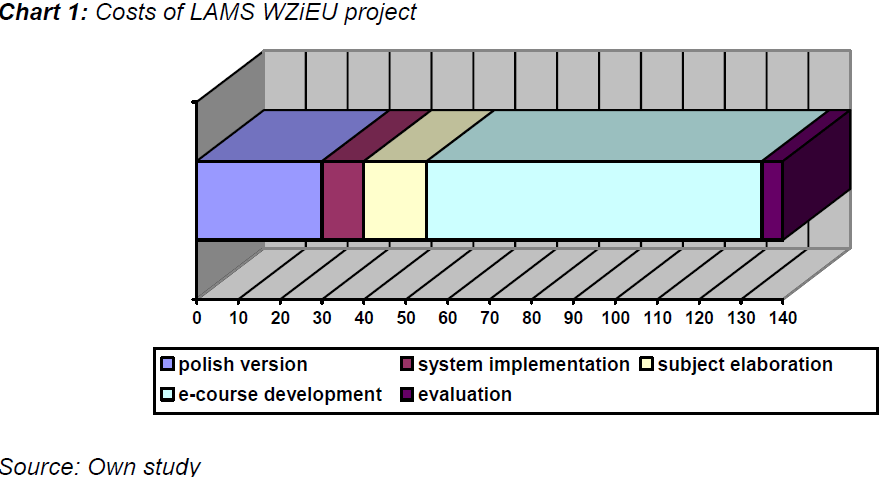 |
| There is a question about the quality of the solutions used, the functionality of the chosen platform and effectiveness of the developed e-course. The answer was determined by analysing data from surveys, (carried out in LAMS) in which students (satisfaction and quality of e-courses) and teachers (platform functionality) participated. |
| Questionnaires were completed by a group of 7 teachers using LAMS for teaching a Computer Science subject using the blended learning method. Of course the small number of respondents may show a Lack of objective results, nevertheless the achieved results may be starting point for deeper analysis. The main advantages raised by teachers were: realization of the subject in the same way by all teachers, comfort of carrying out classes (most of didactic materials were developed previously), ease of knowledge and file distribution, and communication with students after “live” classes etc. As shown in Table 2 which compares traditional and blended learning methods, the benefits of the latter is clearly shown (teachers gave marks in scale from 0 to 5). |
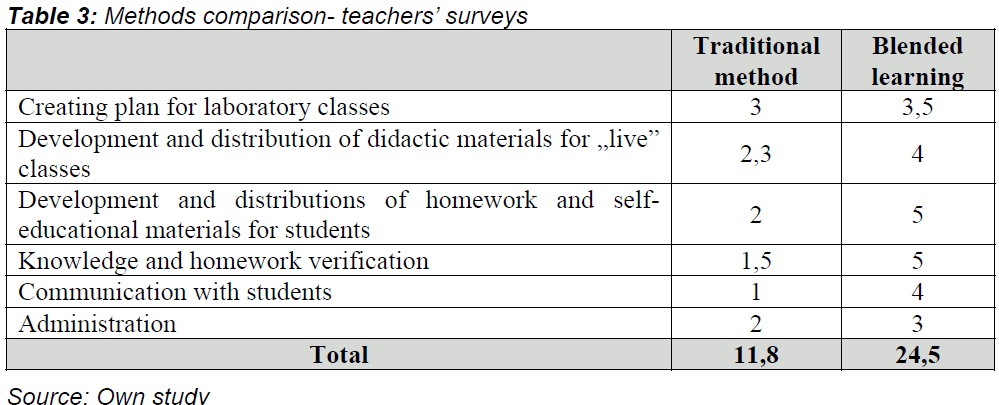 |
| What was an interesting finding in open questions about the disadvantages of blended learning was that the comments were not about the method itself but the e-learning platform. The most common comments were about: easier groups and users’ administration and a greater number of tools helping in didactic process, like individual and cumulative statistics. The final conclusions are very pleasing. Both the e-learning platform and the way of conducting classes were accepted and appreciated by teachers. A return to traditional methods is unlikely. |
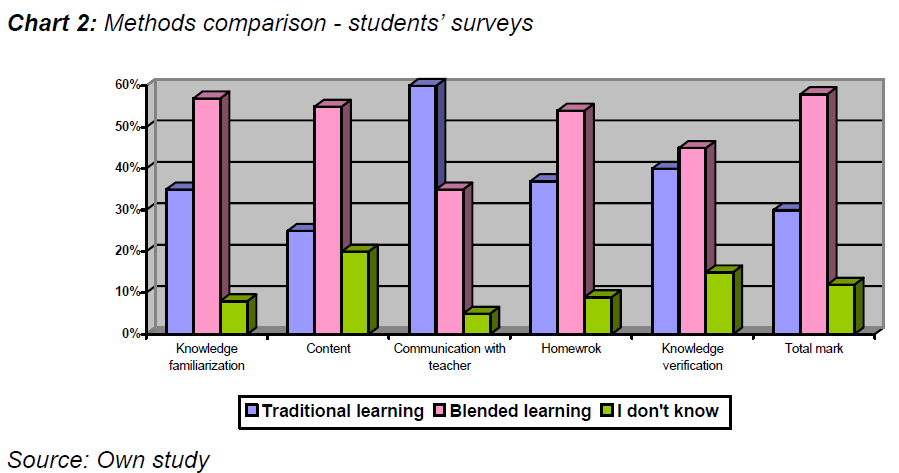 |
| It is very hard to judge educational quality of performed training, especially its efficiency. As a starting point to the analysis of the issue, surveys for students were adopted. Questionnaires were completed by a group of 150 students who participated in schooling delivered with blended learning. |
| As is shown from the executed analysis, the general rating of efficiency and quality of blended learning is twice as high as the traditional method. According to students surveys which results are shown in Chart 2, blended learning is better in each element of the educational process, except communication. It seems that it is very important tip which must be taken into consideration when other e-courses are designed. Essential are solutions for synchronous communication (i.e. chat, not only forum) or, going further, e-consultation tools (i.e. audio/ video online). |
| The research findings from the questionnaire presented in Chart 3 also showed that the most helpful tool for students were animated tutorials (FLASH animation – board tool). The Forum and tool for www sites explorations (Shared Resources) were also very popular, as a “natural” method of searching and gaining information for students between 19 and 25 years old. Tools for downloading and submitting files to the teacher were rated at 30%. |
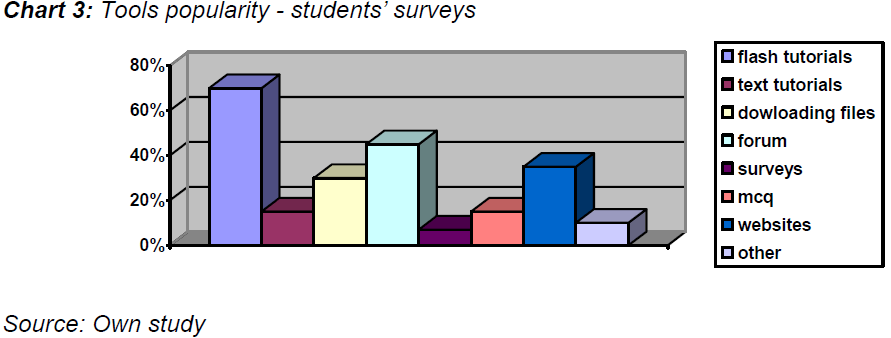 |
| Our research proves that students use interactive tools (animations) and those, which give unlimited possibilities to exchange information and communication (forum, exploration of www sites). The general rating for the efficiency of the method is positive for both students and teachers. The LAMS platform is not faultless, but is an interesting alternative for commercial solutions, especially at the beginning of e-learning route. |
3. Realization of LAMS WZiEU project – stage two |
| Second stage of LAMS WZiEU project started in March 2008. It consisted of: the purchase and installation of a new e-learning dedicated server, the installation of the next version of LAMS (with branching features), evaluation of the Computer Science subject, the design and implementation of new subjects for e-learning and blended learning and integration with the available, open source LMS system. |
| In connection with building wider conception of e-learning implementation on WZiEU, the decision about purchase and installation of the new e-learning dedicated server installation was made. The crucial requirement was the ability to provide efficient and stable work for at least 300 active users logged in LAMS. The choice was solution from Fujitsu Siemens – Primergy RX300 S4 server. The most important technical details of the server: |
| • Chipset: Intel 5000P |
| • CPU: 2x Intel Xenon Quad-Core 2,83 GHz |
| • RAM: 16 GB DDR2 PC2-5300F |
| • HDD: 6x 300GB SAS |
| • LAN: 2x Gbit Ethernet |
| During the first stage of the LAMS WZiEU project, system LAMS was installed on low efficiency server. Because of that it was extremely important to optimize configuration of the server. After several tests it was recognized that factor which had great influence on server performance was java virtual memory setting. Increasing default settings of XMX, XSS and XX memory size caused noticeable improvement in server performance. This modification was also applied to dedicated server. Another crucial factor is internet connection capacity. WZiEU uses symmetric internet connection with 1Gb/s bandwidth. The minimum available bandwidth allocated to e-learning server is set to 100Mb/s. Internet connection capacity does not pose a threat in distributing content to LAMS users. Considering the use of LAMS platform at WZiEU, it should be assumed that WZiEU is well prepared in the field of technical requirements. |
| Content preparation of new e-courses was preceded by: source document analyze, selection of learning model in view of time (synchronous, asynchronous) and the way of content distributing (e-learning, blended learning), choice of tools to present and verify the content and to interact with students taking into account essential features of behavioral and constructiveness approach. |
| During the process of designing the e-course, we concentrated on three aspects, acknowledging their strong interaction with each other: |
| • Didactic – accuracy of the e-course content. |
| • Methodological – converting content into manageable knowledge segments. |
| • Technical – providing accurate, accessible knowledge through the e-learning system. |
| The figure below presents the flow of work and task division that are necessary to realize the e-course (e-learning or blended learning) and outlines the time needed to build particular stages of the course. |
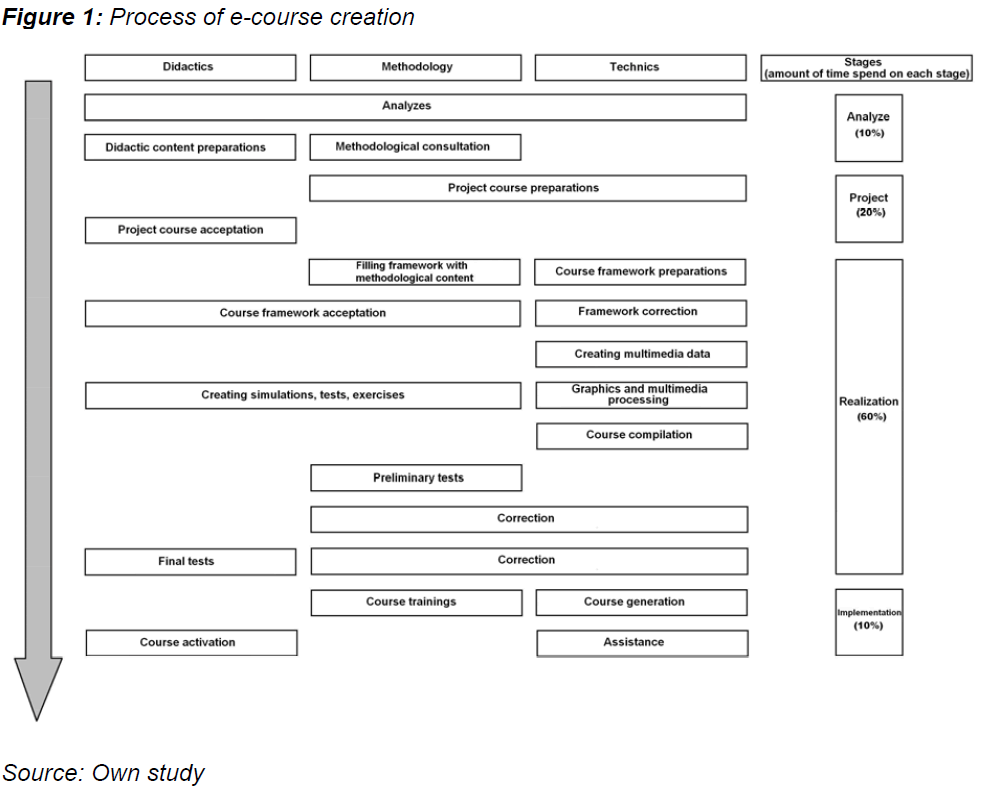 |
| The same approach as shown in Figure 1 can be used to build e-learning or blended learning courses. Similar activities (main course components) were used when preparing courses, which allows us to claim it is the subject characteristic that determines the choice of required activities rather than form of transfer of the knowledge. The basic difference in development of electronic courses is the time needed to prepare the multimedia and interactive elements for e-learning courses. Lack of trainee contact with the teacher highlights the need for the implementation of innovative, interactive learning forms, which engages the trainee and facilitates acquirement of knowledge. That is why the use of more advanced, commercial authoring tools and dedicated programs for multimedia capturing and processing is necessary. The costs incurred while preparing e-learning courses are higher than blended learning courses. Taking into account Polish conditions and the fact that WZiEU has just started to use remote teaching techniques, the choice a blended learning model seems to be the correct one. |
| The main aims of second stage of LAMS WZiEU project were: LAMS system installation on dedicated server, development of new e-courses and LAMS system popularization in academic and business environments. Moreover, other activities were taken: |
| • to use synchronous learning techniques, |
| • to integrate with Moodle system. |
| WZiEU has got branches located in neighbouring cities, where classes are carried out in extramural mode. To limit frequent trips of WZiEU academic teachers, actions were taken to apply synchronous learning techniques. Within second stage, there were held on-line consultation to Computer Science subject. Because LAMS system does not have any inbuilt tools which enable synchronous communication (apart from chat), it was decided to use two free of charge programs: |
| • Skype – popular communicator which enables talks and audiovisual conferences. |
| • TightVNC – program which enables remote work with one or more computers. |
| Conducting on-line consultation was possible because of the mechanism implemented in programs mentioned above: |
| • synchronous video transmission, |
| • voice transmission (VoIP), |
| • virtual blackboard, |
| • desktop sharing. |
| LAMS system allows integration with several LMS system. As s result of functional analyse of available systems (only open source systems where considered), the decision to select Moodle system was made. The process of integration with Moodle system (ver. 1.9.2+) has been successfully finished. Combining benefits of the Course Management System (Moodle) with the Learning Design system (LAMS) might significantly enhance effectiveness of didactic process and create new generation of e-learning technology. Within second stage of LAMS WZiEU project intensive tests of Moodle-LAMS platform had been conducted before it was accessible for teachers and students. |
4. Summary |
| The second stage of LAMS WZiEU project was finished. Now it is time to evaluate the new e-learning server, new version of Learning Activity Management System and implemented e-courses. Taking into consideration the fact that there are more academic teachers interested in using LAMS system during classes, LAMS WZiEU team is preparing to formulate foundations for next stages of LAMS WZiEU project. The third stage will assume applying integrated Moodle-LAMS platform and taking the action to make e-learning be treated as prospective direction of didactic evolution at WZiEU. |
References |
|
Copyright © 2025 Research and Reviews, All Rights Reserved